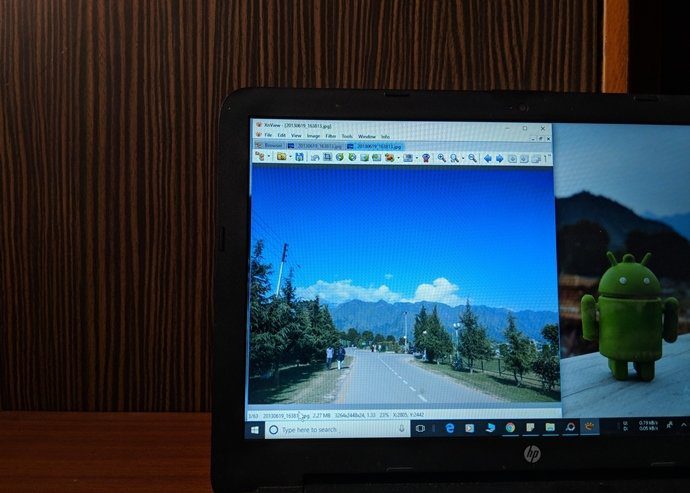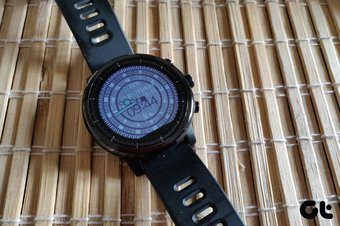Hence, it begets the common question — which smartwatch is better? What are the differences that make the GTR pricier than its counterpart? Well, that’s what we are going to answer in this post today when we compare the Amazfit GTR against the Amazfit GTS. As it’s going to be a long post, let’s get started, shall we?
Specs That Matter
Design: Which Watch Is ‘More’ Stylish
If you care about a beautiful and sleek smartwatch, the Amazefit GTR and the GTS doesn’t disappoint. Aforementioned, the GTS sports a rectangular dial, and the slim form factor of this wearable adds to its looks. We got the black variant of the GTS in the office, and we loved how the inky blackness of the AMOLED display blended seamlessly with the rest of the smartwatch. There’s a single button on the right side, which functions as the Home button. Plus, the silicon straps are sleek and made of breathable material, meaning you can wear this watch continuously without feeling uncomfortable or the skin itching. As opposed to it, the GTR sports a circular dial and somewhat resembles the Galaxy Watch (although not in heft), with a ceramic bezel surrounding the watch. While this adds a cool factor to the watch, do note that it’s prone to scratches if you are not careful. These bezels, along with the two buttons at the side, give the watch a classic and premium look. The GTR is available in two sizes of 42mm and 47mm. Both watches have Corning Gorilla tempered glass, and this addition makes sure that the watch face is free of scratches, abrasions, and other damages. During our usage, we haven’t seen any noticeable damages on both the watches, albeit a few micro scratches.
Display
Amazfit has overhauled the display of its smartwatches by several folds. If you recollect, the Bip and the Stratos had very underwhelming displays. Thankfully, the company has worked on this, and now, both the GTS and the GTR have amazing displays. The AMOLED screens are bright, vibrant, and colorful. And the Always-on Display is the cherry on top. If we talk numbers, the 1.65-inch AMOLED screen of the GTS has a pixel density of 341-PPI while the 1.39-inch AMOLED display boasts of 326-PPI pixel density. For the layman, the display on both phones looks almost the same. And the inclusion of Always-on Display means you can check the time and the steps you have taken without waking up the phone. At the same time, both the watches an ambient brightness sensor that adjusts the screen’s brightness as per the ambient light, thus saving battery life in the long run.
Lifestyle Features and Tracking
When it comes to features, you can expect nearly similar activity features in both wearables. Let’s begin with the similarities first. Both watches can track steps, distance traveled, calories burned, and can also display the altitude as well as the air pressure of your current location. Apart from that, you have easy access to the heart-rate monitor and the sleep tracker. However, I would not trust the sleep tracking in it to be fully accurate. Both the GTS and the GTR comes with 12 sports modes and can track your walks, swims and your runs. And the built-in GPS helps the case. When it comes to tracking, the results are almost accurate. It regularly reminds you to get up and take a few steps if you have been idle for too long. During our usage, we didn’t find any miscalculation of steps that is common with regular fitness trackers. Plus, both smartwatches come with a bevy of watch faces. Plus, you can also customize your watch face. It lets you pick the background image and lets you choose the type of dial as well. Speaking of the smart side of these smartwatches, unfortunately, there isn’t much. While both these wearables let you control your smartphone’s music from your wrist, you won’t be able to store music on them since they do not have onboard storage. On the upside, you can see your phone’s notification on the watch. However, you can’t make calls or talk on these watches. You can’t arrange the widgets (what little is there) as per your choice. In a nutshell, if you are looking for widgets and smart features like those in the Apple Watch or Samsung Galaxy Active 2, you’ll be disappointed.
Battery Life
One of the primary differences between both these smartwatches is battery life. The Amazfit GTS is powered by a 220mAh battery unit, which can power the smartwatch for approximately 14 days. And though the battery life mainly depends on several factors like screen brightness, heart rate monitoring, or the number of unlocks, the claim is almost true. In our case, the GTS stayed on for 11 days straight before it needed a charge. Impressive, right? As opposed to it, the Amazfit GTR (47mm) is powered by a 410mAh battery that the makers claim has a battery life of 24-days on a single full charge (12-days for the 42mm). Compared to its peers, this battery life is pretty impressive. Take the Galaxy Active 2 for that matter, which can barely last three days on a full charge. Of course, it packs a few more features, but here we are strictly talking about battery life.
Decisions. Decisions.
When it comes to features, both the Amazfit GTR and Amazefit GTS bundle the same features, including the 5ATM water resistance. However, if you look beyond that, you will see that there are several differences between the two. Though the Amazit GTS has a cool new look, however, I find its form factor to be a bit too slim and is best suited for regular casual wear. But if you have to attend a formal event, you’d want to swipe it out for a more traditional wearable. The Amazfit GTR has a longer battery life and looks more classy than its counterpart, thanks to the circular dial. And if you opt for an analog watch dial, the GTR can almost double as a traditional watch. It has the right heft and the right weight that makes it perfect for both formal and casual occasions. The above article may contain affiliate links which help support Guiding Tech. However, it does not affect our editorial integrity. The content remains unbiased and authentic.













![]()



